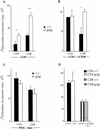The absence of Tssc6, a member of the tetraspanin superfamily, does not affect lymphoid development but enhances in vitro T-cell proliferative responses
- PMID: 12077330
- PMCID: PMC139789
- DOI: 10.1128/MCB.22.14.5006-5018.2002
The absence of Tssc6, a member of the tetraspanin superfamily, does not affect lymphoid development but enhances in vitro T-cell proliferative responses
Abstract
The tetraspanins are a family of integral membrane proteins with four transmembrane domains. These molecules form multimolecular networks on the surfaces of many different cell types. Gene-targeting studies have revealed a role for tetraspanins in B- and T-lymphocyte function. We have isolated and deleted a novel tetraspanin, Tssc6, which is expressed exclusively in hematopoietic and lymphoid organs. Using a gene-trapping strategy, we generated an embryonic stem (ES) cell line with an insertion in the Tssc6 locus. Mice were derived from these ES cells and, using RNase protection and reverse transcription-PCR, we demonstrated that the insertion resulted in a null mutation of the Tssc6 allele. Mice homozygous for the gene trap insertion (Tssc6(gt/gt) mice) were viable and fertile, with normal steady-state hematopoiesis. Furthermore, responses to hemolysis and granulocyte colony-stimulating factor-induced granulopoiesis were equivalent to those of wild-type mice. Lymphoid development was normal in Tssc6(gt/gt) mice. Whereas Tssc6(gt/gt) B cells responded normally to lipopolysaccharide, anti-CD40, and anti-immunoglobulin M stimulation, Tssc6(gt/gt) T cells showed enhanced responses to concanavalin A, anti-CD3, and anti-CD28. This increased proliferation by Tssc6-deleted T lymphocytes was due to increased interleukin 2 production following T-cell receptor stimulation. These results demonstrate that Tssc6 is not required for normal development of the hematopoietic system but may play a role in the negative regulation of peripheral T-lymphocyte proliferation.
Figures







References
-
- Abe, R., P. Vandenberghe, N. Craighead, D. S. Smoot, K. P. Lee, and C. H. June. 1995. Distinct signal transduction in mouse CD4+ and CD8+ splenic T cells after CD28 receptor ligation. J. Immunol. 154:985-997. - PubMed
-
- Cannons, J. L., P. Lau, B. Ghumman, M. A. DeBenedette, H. Yagita, K. Okumura, and T. H. Watts. 2001. 4-1Bb ligand induces cell division, sustains survival, and enhances effector function of CD4 and CD8 T cells with similar efficacy. J. Immunol. 167:1313-1324. - PubMed
-
- Claas, C., C. S. Stipp, and M. E. Hemler. 2001. Evaluation of prototype TM4SF protein complexes and their relation to lipid rafts. J. Biol. Chem. 276:7974-7984. - PubMed
-
- Clay, D., E. Rubinstein, Z. Mishal, A. Anjo, M. Prenant, C. Jasmin, C. Boucheix, and M. C. Le Bousse-Kerdiles. 2001. CD9 and megakaryocyte differentiation. Blood 97:1982-1989. - PubMed
-
- Deeths, M. J., and M. F. Mescher. 1997. B7-1-dependent co-stimulation results in qualitatively and quantitatively different responses by CD4+ and CD8+ T cells. Eur. J. Immunol. 27:598-608. - PubMed
Publication types
MeSH terms
Substances
LinkOut - more resources
Full Text Sources
Other Literature Sources
Molecular Biology Databases
Research Materials
Miscellaneous
